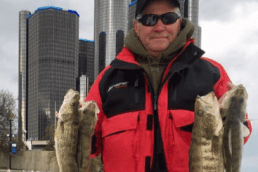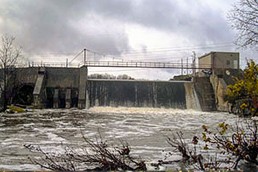Islands in the River
SHARE THIS POST
In five short years, a dying, silted-in area of the Illinois River has become a deep-water fishery, with lush green islands with pockets of wetlands, areas of natural grasses, young trees, a new resting and nesting place for song birds, migratory waterfowl, wind born insects and hopefully small animals.
Started in 2009 by the U. S. Army Corps of Engineers, the original purpose was to restore deep-water fisheries habitat that had been lost through sedimentation in Lower Peoria Lake. Since the dredged material had to be placed somewhere, the creation of the island within the area seemed beneficial both financially and for the habitat. By improving the depth diversity of the local waters, there would be an enhanced habitat not only for the fish and waterfowl, but a future enriched recreational benefit.
Before beginning the project, the acres of silted-in water had a depth of less than two feet with some portions less than a foot. Afterwards, the dredged waters average from six to almost eight feet, with some potholes as deep as 20 feet. It is on the cusp of developing into a great fishery with shallow borders for spawning, wading birds and water plants.
The innovative use of stacked, sediment-filled geotextile containers to define the shape of the islands allowed the use of locally dredged material for shaping and filling the new habitat. The process was new, starting with dry dredging, using a 630 HP Caterpillar Diesel Engine to pump the material through a hopper and into the geotextile containers in the same way concrete is pumped for high-rise concrete placement.
These containers made of high strength woven polypropylene fibers are 45 feet in circumference, 100 feet long for straight portions and 60 feet long for curves. They are about six feet high after filling, but subside to about five feet after one year. The bags were stacked pyramid-style with the initial row three wide and the top rows made up of only one bag. Water in the dredged material can seep through the containers resulting in dense material within.
The mid-sized island created above the bridge (Route 150) and the pair of islands below it used 200 acres of dredged material to create 75 acres of islands in all. Broken down, 55 acres of dredged material created a 5-foot backwater channel and maintained the channel at 9 feet. The result was the 21-plus-acre island upstream and downstream, a pair of islands totaling about 50 acres, which utilized almost 150 acres of dredged material would have been deposited someplace else if the islands weren’t created.
Are you enjoying this post?
You can be among the first to get the latest info on where to go, what to use and how to use it!
In the intervening years, even as the project was under construction and the fill rose above water level, seeds blew in. Now, all of the islands are now mostly covered with vegetation. There are wild grasses, reeds, flowers, willow, cottonwood, honey locust and maple trees. The original plans called for elevating the island above what is allowed by flood plain statutes, so along one side of the islands there is a high berm approximately 2000 feet by 10 feet that is high ground. The rest of the land is grassy with occasional areas of marshy wetland.
There is still the hope that in the future, the island elevation will stabilize and more parts will be high enough so a few hardwood and nut trees can be planted. The islands are alive with migrating waterfowl during the “fly” periods and have some nesting birds along with a variety of local and songbirds. Recently, the windborne seeds have begun sprouting even on the sediment filled bags, forming the island perimeters, eventually masking all evidence of their man-made origin.
The fishery around and behind the islands is improving every season and could become one of the area’s best. At present, the islands are not open for public use and bird watchers and fishermen are asked to stay in their boats.
The original funding for the project was 65 percent from federal funding and 35 percent from the state of Illinois. The initial studies, planning, engineering and work were done under the supervision of the U. S. Army Corps of Engineers supervised mostly through the Engineers at the Clock Tower at the Rock Island Arsenal. After a final inspection, it will be turned over to the Illinois Department of Natural Resources, which will then manage and regulate the use of the islands.
Originally, there was some controversy about the project, but right now it seems to have accomplished a number of positive goals. It has restored the silted in deep water fishery in Lower Peoria Lake, utilized the dredged materials to create islands for migratory and other wildlife and holds a promise for future recreational use. In talking with Anthony Heddlesten, the Environmental Engineer heading up the project for the Rock Island District U. S. Army Corps of Engineers and Debbie Bruce with the Illinois Department of Resources in Springfield, I got the feeling that this was a well-thought out, well-executed plan that spent tax payer money in a positive way. The project yielded two environmental prizes, the recycling of dredged material and environmental habitat for flora, fauna and the fishes.
MWO
SHARE THIS POST
Did you enjoy this post?
You can be among the first to get the latest info on where to go, what to use and how to use it!
Bess Pierce
Before Dick and Bess Pierce married, they fished. When he was laid off, they set 1000-hook jump lines, daily, to pay bills. They’ve fished rivers and the Great Lakes with children and grandchildren. From a lifetime of experiences, Bess Pierce writes basic how-tos, where-tos and the joy of the Midwest, with an emphasis on outdoor experiences for families. She may be contacted at gemini2624@aol.com.


